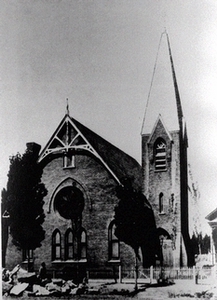BAPTISTS IN UTAH

Baptist Church, Ogden
Members of the Baptist Church first entered Utah Territory as part of the general influx of Protestant evangelical faiths following the completion of the transcontinental railroad. These evangelicals came to support the growing non-Mormon populace and to attempt to persuade young Mormons to their cause through education. After a slow start, the Baptist Home Missions Society operated several schools in the territory from 1883 to 1900. However, changing economic, political, and religious conditions in Utah and the nation led to the closure of all early Baptist schools in Utah by the turn of the century.
The first Baptist congregation in Utah Territory was established by George W. Dodge. Dodge was appointed Superintendent of Indian Affairs for the territory by President U.S. Grant, and arrived in Salt Lake City in 1871. Dodge, a staunch Baptist, began to look for other Baptists in Salt Lake and started a small Baptist congregation with twenty members later that year. Dodge was recalled to Washington, D.C., in 1873; with him went the driving force behind this early Baptist movement in Utah. The congregation struggled for several years before finally disbanding in 1875.
The Baptist movement in Utah Territory lay dormant from 1875 to 1881. In May 1881 Reverend Dewight Spencer arrived in Ogden and immediately established the Ogden Baptist Church. The members initially met in various homes, but thanks to Spencer's tireless fund-raising efforts in the East, a church building was completed in May 1882. Spencer concentrated his efforts in Salt Lake City the following year, establishing the First Baptist Church of Salt Lake in August 1883. He again went to the East Coast to raise funds for the construction of a building. The First Baptist Church of Salt Lake was completed in May 1884.
Baptist missionary efforts led to the establishment of thirteen churches and five "preaching stations" in Utah between 1884 and 1900. These were scattered throughout Utah's railroad and mining areas, but most members were found in either Salt Lake or Ogden. This was due in part to the transient nature of Baptist members and workers. Utah's non-Mormon population consisted largely of persons associated with the railroad or mining industries. These persons were subject to changing economic and work opportunities and often moved from one area to another. In Utah, these industries were concentrated in the Salt Lake and Ogden areas, which therefore provided the most stable congregations. Baptist missionary or church workers are not assigned to specific locations by a central church hierarchy. Workers instead move from one location to another as opportunity becomes available. These factors influence the creation and disbanding of congregations depending upon economic conditions.
The geographic expansion of Utah's Baptist Church was further limited by the comity agreements established by the mainline Protestant faiths beginning in 1915. These agreements recognized the limited resources of Utah's Protestants and the numerical dominance of the Mormon Church. The agreements acknowledged the similar doctrines of the mainstream Protestant churches and then divided Utah and its major population centers among the various faiths. The comity agreements allowed the faiths to concentrate their limited resources within specific areas, but did allow the continuance of current churches. The result for Baptists was a rise in membership in Salt Lake and Ogden as well as the southeast portion of Utah (Price and Moab) during the first half of the twentieth century.
Baptist theology emphasizes the primacy of the individual believer and the authority of the local church. Nationally, the desire for individual/local autonomy and the lack of a powerful central authority resulted in a number of diverse associations calling themselves Baptist. The major division occurred in 1845 when Baptists divided into the Northern (later American) and the Southern Baptists. This division was effected to decentralize the administrative authority of the growing Baptist denomination. Later divisions were the result of differences over doctrinal issues or practices or from a desire to address specific ethnic issues. Although one or two individual churches representing other Associations did appear from 1890 to 1940, most Baptists prior to 1940 belonged to the American Baptist Association. The Southern Baptist Association began its evangelical efforts in Utah during the 1940s; the effort peaked during the 1960s. Several other associations with early representation, such as the Conservative Association (Bethel Church), were later joined by various conservative and independent Baptist congregations during the 1960s and 1970s. Utah's Baptists and their major associations are well represented among the Protestant faiths in Utah at the present time.
Two ethnic Baptist associations were also represented in early Utah. Calvary Baptist (1896) and the Negro Baptist Church of Ogden (1914) both began as American Baptist churches and later aligned with the predominantly black National Baptist Association. Two Scandinavian missionaries also came to Utah as American Baptists during the 1880s. They did not meet with much success among the predominantly Mormon Scandinavian population yet decided to establish a Salt Lake branch of the Swedish Baptist Church in 1891. Swedish mission churches were established both in Salt Lake City and in Murray; however, both failed and the Swedish Baptists again aligned with the American Baptist Association.
The growth of the Baptist Church in Utah is evidenced in the number of professing individuals and in the number of associations represented. Even though the American Baptists dominated the early scene, Southern, National, Conservative, and Independent Baptist congregations have been growing throughout the last half-century. These congregations represent the general change that has occurred as Utah aligned itself with larger social and economic movements in the United States during the later twentieth century.
Disclaimer: Information on this site was converted from a hard cover book published by University of Utah Press in 1994. Any errors should be directed towards the University of Utah Press.